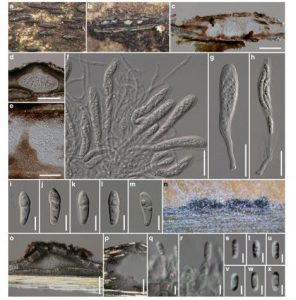Seriascoma didymospora S.C.Karunarathana & K.D. Hyde, sp. nov. Index Fungorum number: IF628056
Etymology: The epithet didymospora^ refers to the ascospores having two cells.
Holotype: MFLU 11–0215
Saprobic on bamboo culms. Sexual morph: Ascostromata 150–320 μm high, 1000–1900 μm diam., gregarious, clustered, immersed beneath clypeus, coriaceous, raised, erumpent in linear rows, with slit-like opening, multi-loculate, ostiolate. Locules 120–230 μm high, 180–300 μm diam., arranged in rows, clustered, gregarious, subglobose to ampulliform, glabrous, central ostiole with minute papilla. Peridium 15–85 μm wide, thin- to thick-walled, sometimes unequal in thickness, thicker at the sides towards apex, thinner at the base, composed of several layers of small, dark brown pseudoparenchymatous cells of textura angularis. Hamathecium composed of 2–2.5 μm wide, broad, filamentous, distinctly septate cellular pseudoparaphyses. Asci (56–)60–75(−80) × 8–11(−13) μm (x = 68 × 10 μm, n= 30), 8-spored, bitunicate, fissitunicate, clavate, long pedicellate, with furcate to obtuse ends, apically rounded, with well developed ocular chamber. Ascospores 11–12(−14.5) × 3– 4 μm (x = 11.9 × 3.9 μm, n = 30), overlapping, uni- to triseriate, didymosporous, clavate to fusiform, with rounded ends, hyaline, slightly constricted at the septum, straight to curved, with upper cell shorter and wider than lower cell, smooth-walled, with large and small guttules. Asexual morph: Coelomycetous, produced on bamboo pieces on WA after 4 months. Conidiomata 110–170 μm high, 250–470 μm diam., eustromatic, solitary to gregarious, semi immersed in cortex layers, to erumpent, raised, black, elongate on bamboo pieces, conical, uni-loculate, glabrous, covered by vegetative hyphae. Wall of conidiomata 8–80 μm thick, thin to thick-walled, of unequal thickness, thick at the sides, comprised of host and fungi tissue, with several layers of dark brown to black, pseudoparenchymatous cells of textura angularis. Conidiophores arising from the base of the cavity, reduced to conidiogenous cells. Conidiogenous cells 4– 7(−8) × 1.5–3 μm (x = 5.7 × 2.4 μm, n = 30), enteroblastic, phialidic, determinate, discrete, cylindrical to ampulliform or lageniform, hyaline, aseptate, apically attenuated, with distinct periclinal thickening, smooth-walled. Conidia 4–5.5 × 1.5–2 μm (x = 4.9 × 1.9 μm, n = 30), oblong, with rounded to obtuse ends, hyaline, aseptate, smooth-walled.
Culture characters: Colonies on PDA fast growing, 64– 73 mm diam. after 4 weeks at 25–30 °C, under 12 h light/ 12 h dark, colonies circular, dense, flat, slightly raised, smooth with entire edge, velvety to floccose, slightly radiating, aspect smooth, slightly raised at the centre, dull green to dark green from above, blackish green from below.
Material examined: THAILAND, Chiang Rai Province, Mae Jun District, Huai Kang Pla waterfall, on dead clums of bamboo, 25 October 2010, R. Phookamsak, RP0095 (MFLU 11–0215, holotype), ex-type living cultures, MFLUCC 11– 0179, KUMCC; Muang District, Khun Korn waterfall, on dead culms of bamboo, 13 January 2011, S.C.Karunarathana, RP0110 (MFLU 11–0230, paratype), living cultures, MFLUCC 11–0194, KUMCC.
FIG. Seriascoma didymospora (MFLU 11–0215, holotype). a Appearance of ascostromata on host surface (MFLU 11–0230). bHorizontal section through ascostroma (MFLU 11–0230). c Vertical section through ascostroma (MFLU 11–0230). d Section through locule (MFLU 11–0215). e Section through peridium (MFLU 11–0230). f Asci with pseudoparaphyses (MFLU 11–0230). g–h Asci (MFLU 11–0230). i–m Ascospores (MFLU 11–0230). Asexual morph from MFLU 11– 0215: n Rows of conidiomata produced on bamboo pieces on WA. o Section through conidiomata. p Conidiomata wall. q–r Conidiogenous cells. s–x Conidia. Scale bars: c = 200 μm, d, o = 100 μm, e, p = 50 μm, f– h = 20 μm, i–m=5 μm, q–x=2 μm

